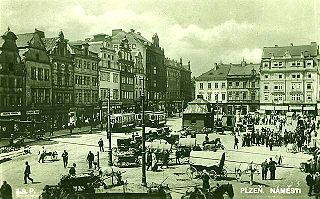
Main Square of Plzen
Encyclopedia

Czech language
Czech is a West Slavic language with about 12 million native speakers; it is the majority language in the Czech Republic and spoken by Czechs worldwide. The language was known as Bohemian in English until the late 19th century...
Naměstí republiky) forms historical centre of Plzeň, Czech Republic
Czech Republic
The Czech Republic is a landlocked country in Central Europe. The country is bordered by Poland to the northeast, Slovakia to the east, Austria to the south, and Germany to the west and northwest....
. With size of 552 x 627 ft it is one of the largest medieval squares in the Czech lands
Czech lands
Czech lands is an auxiliary term used mainly to describe the combination of Bohemia, Moravia and Czech Silesia. Today, those three historic provinces compose the Czech Republic. The Czech lands had been settled by the Celts , then later by various Germanic tribes until the beginning of 7th...
.
Plzeň as a town appears at the end of 13th century, the square existing since then. Around the oblong square regular blocks of houses delimitated by a rectangular network of streets were built.
Archaeologists had identified wooden pavement from 13th century and another three layers of pavement from 14th century . The square was cobblestoned in 1859. The stones were replaced by asphalt
Asphalt
Asphalt or , also known as bitumen, is a sticky, black and highly viscous liquid or semi-solid that is present in most crude petroleums and in some natural deposits, it is a substance classed as a pitch...
cover in 20th century; this replaced again with cobblestones during 2005-2007 reconstruction.
In the beginning of the 16th century water supply became critical. Water tower with a mechanical pump was erected, the water being stored in lead
Lead
Lead is a main-group element in the carbon group with the symbol Pb and atomic number 82. Lead is a soft, malleable poor metal. It is also counted as one of the heavy metals. Metallic lead has a bluish-white color after being freshly cut, but it soon tarnishes to a dull grayish color when exposed...
en reservoir and led through wooden pipes to public fountains at the main square.
A graveyard had existed on the square since the town was established until 1789, when Emperor Joseph II
Joseph II, Holy Roman Emperor
Joseph II was Holy Roman Emperor from 1765 to 1790 and ruler of the Habsburg lands from 1780 to 1790. He was the eldest son of Empress Maria Theresa and her husband, Francis I...
ordered to close such graveyards.
The buildings in the square are of predominantly Gothic and Renaissance
Renaissance
The Renaissance was a cultural movement that spanned roughly the 14th to the 17th century, beginning in Italy in the Late Middle Ages and later spreading to the rest of Europe. The term is also used more loosely to refer to the historical era, but since the changes of the Renaissance were not...
style. In the courtyards on the east side remains of the medieval walls are still preserved. The best preserved part of the square is its southern part.
Many buildings contain two or three levels of cellars used to preserve food, for wells or just as cesspools .
The most important historical landmarks are Church of St. Bartholomew
Cathedral of St. Bartholomew (Plzen)
The Cathedral of Saint Bartholomew dominates the city center of Pilsen in the Czech Republic.The construction of the Gothic style building, located on the main square, started in 1295 and was finished by the beginning of 16th century.The building is 58m long, 30m wide and the spires are 25m high...
(1295, since 1993 a cathedral), the city hall (the building serves as city hall since 1496) and St. Mary's plague column from 1681 by the Plzeň sculptor Kristian Widman , all in the northern part of the square.
External links
- Short overview of the square
- Historically important buildings in the square
- Information about current (2005-2007) reconstruction of the square: http://info.plzen-city.cz/article.asp?itm=5775, http://info.plzen-city.cz/article.asp?itm=10244 (in Czech)

